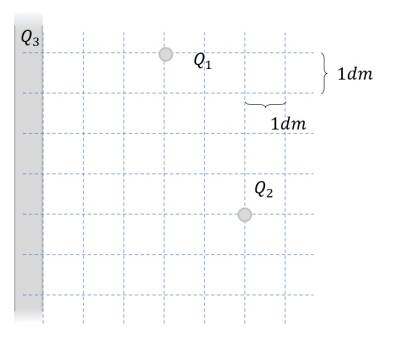Dies ist eine alte Version des Dokuments!
Aufgabe 5.1.5 Variation: Forces on Charges (exam task, ca 8% of a 60 minute exam, WS2020)
Given is an arrangement of electric charges located in a vacuum (see picture on the right).
The charges have the following values:
$Q_1=2 μC$ (point charge)
$Q_2=-4 μC$ (point charge)
$Q_3=0 C$ (infinitely extended surface charge)
$\varepsilon_0=8,854\cdot 10^{-12} F/m$ , $\varepsilon_r=1$
1. calculate the magnitude of the force of $Q_2$ on $Q_1$, without the force effect of $Q_3$.
\begin{align*}
|F_C| = 0,3595 N -> 0,36 N
\end{align*}
2. is this force attractive or repulsive?
The force is attractive because the charges have different signs.
Now let $Q_2=0$ and the surface charge $Q_3$ be designed in such a way that a homogeneous electric field with $E_3=100 kV/m$ results.
What force (magnitude) now results on $Q_1$?
\begin{align*}
|F_C| = 0,4 N
\end{align*}
